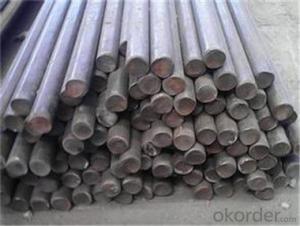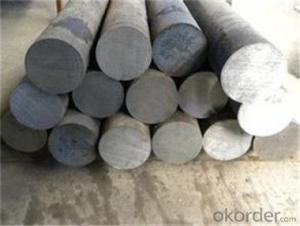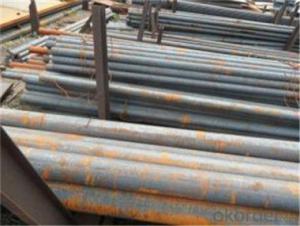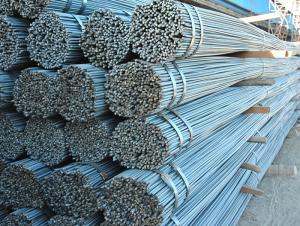Steel Round Bar Reliable Manufacturer with Standard High Quality
- Loading Port:
- Tianjin
- Payment Terms:
- TT OR LC
- Min Order Qty:
- 100 m.t.
- Supply Capability:
- 2000000 m.t./month
OKorder Service Pledge
OKorder Financial Service
You Might Also Like
Description of steel round bar:
Diamater:Ø12mm-Ø650mm
Length: standard 6m,9m,12m, If you need special lengths,please tell us.
Surface: Bare, polished, grinded,varnished
Process:Hot rolled,cold drawn,forged,wrought
Festures of steel round bar:
Inspection: 100% UT test, mill test certificate, third party inspection such as SGS,BV etc.
Packing: In bundle, tied by steel straps, covered with protecting film. Use wooden box, filled with foam to keep the surface from damaging ,scratches,crash etc.
Specifications of steel round bar:
Description | steel round bar | |
Material | ASTM /AISI | 1005,1006,1008,1010,1015,1020,1025,1030,1035, 1040,1045,1050,1055,1060,1065,1070,1080,1084 |
DIN | Ck10,Ck15,Ck22,Ck25,Ck30,Ck35,Ck40,Ck45,Ck50, 30Mn4,40Mn4,1.7225,1.7220,1.7218,1.7016,1.6523 | |
Standard | GB/T799,ASTM A29,A36,A108,A321,A575,BS970,DIN1652,JIS G4051 | |
cross section | Round Other shape:square,hexagonal,flat,angle,rectangular | |
Surface | Black, galvanized,grinded,varnished,bare | |
Specifications | Round bar | Diameter: 12mm~650mm |
Angle bar | Size: 3mm*20mm*20mm~12mm*800mm*800mm | |
Square/ bar | Size: 4mm*4mm~100mm*100mm | |
Flat bar | Thickness: 2mm~100mm | |
Width:10mm~500mm | ||
Hexagonal | Size: 4mm~800mm | |
Length | Standard 6m,9m,12m or as required. | |
Trade terms | Payment terms | T/T,L/C,Western Union,negotiable etc. |
Price terms | FOB,CIF,CFR,EXW etc. | |
Applications | Steel round bar is widely used for all general fabrication and repairs in industrial maintenance, agricultural implements, transportation equipment, ornamental work frame work, braces, supports, shafts,axels,etc. Hot rolled Steel round bars have a slightly grain textured finish. | |
Images of steel round bar:
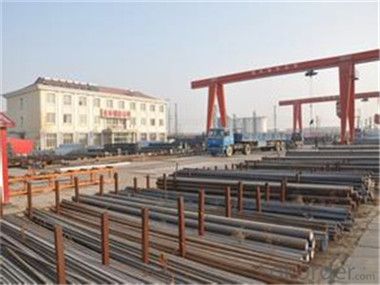
FAQ:
1. What is your package?
Packing situation: standard seaworthy packing or as customer required.
2. How long is the lead time?
Delivery time: 45 days after order confirmed.
3. What payment term do you accept?
Payment: T/T or L/C at sight.
- Q:Can steel round bars be used for making architectural or decorative elements?
- Yes, steel round bars can be used for making architectural or decorative elements. They are versatile and can be shaped, welded, and fabricated into various designs, giving them the potential to enhance the aesthetic appeal of architectural structures or serve as decorative elements.
- Q:Can steel round bars be used in the construction of bridges?
- Yes, steel round bars can definitely be used in the construction of bridges. Steel round bars are commonly used in bridge construction due to their high strength, durability, and versatility. They offer excellent load-bearing capabilities and can withstand heavy loads, making them suitable for use in bridge beams, columns, and other structural elements. Additionally, steel round bars can be easily welded, bent, and formed into various shapes and sizes, allowing for customized designs and efficient construction processes. The use of steel round bars ensures the structural integrity and longevity of the bridge, making them a popular choice in bridge construction worldwide.
- Q:What are the different surface defects that can occur in steel round bars?
- There are several different surface defects that can occur in steel round bars. These defects can be classified into various categories based on their appearance and severity. Some of the common surface defects include: 1. Scale: Scale is a thin layer of oxide that forms on the surface of steel during the manufacturing process. It appears as a rough, flaky coating and can be easily removed by mechanical means. 2. Pits: Pits are small depressions or craters that can occur on the surface of the steel. They are usually caused by corrosion or mechanical damage. Pits can weaken the structural integrity of the steel and may require repair or replacement. 3. Scratches: Scratches are shallow grooves or cuts on the surface of the steel. They can be caused by handling, transportation, or machining processes. While minor scratches may not affect the performance of the steel, deep scratches can lead to stress concentration and potential failure. 4. Roll marks: Roll marks are raised or depressed lines or patterns that are left on the surface of the steel during the rolling process. These marks are typically caused by the uneven pressure distribution between the rolls and can affect the dimensional accuracy and surface quality of the steel. 5. Laminations: Laminations are thin layers or bands of non-metallic inclusions that can occur parallel to the surface of the steel. They are usually caused by inadequate refining or improper casting techniques. Laminations can decrease the strength and toughness of the steel and may require further processing or rejection. 6. Decarburization: Decarburization refers to the loss of carbon content on the surface of the steel. It can occur during heating, annealing, or hot working processes. Decarburization can reduce the hardness and strength of the steel and may lead to premature failure under load. 7. Surface cracks: Surface cracks are visible cracks that occur on the surface of the steel. They can be caused by excessive cooling rates, improper heat treatment, or mechanical stress. Surface cracks can compromise the structural integrity of the steel and may require repairs or rejection. These are just a few examples of the different surface defects that can occur in steel round bars. It is essential to inspect and address these defects to ensure the quality and performance of the steel in various applications.
- Q:What are the different methods used for machining steel round bars?
- There are several methods used for machining steel round bars, each with its own advantages and applications. Some of the commonly used methods include: 1. Turning: This is a widely used method that involves rotating the steel round bar against a cutting tool, which removes material and creates the desired shape. Turning is suitable for both external and internal operations and can achieve high precision and surface finish. 2. Milling: In milling, a rotating multi-tooth cutter removes material from the steel round bar to create flat or contoured surfaces. This method is versatile and can be used for various operations, including face milling, slotting, and profiling. 3. Drilling: Drilling involves creating holes in the steel round bar using a rotating drill bit. This method is commonly used for creating holes of different sizes and depths, and can be done manually or through automated processes. 4. Grinding: Grinding is a precision machining method that uses abrasives to remove material from the steel round bar. It is commonly used to achieve a smooth surface finish, tight tolerances, and precise dimensions. Grinding can be performed using various types of grinding machines, such as cylindrical grinders or surface grinders. 5. Boring: Boring is used to enlarge existing holes or create internal cylindrical shapes in the steel round bar. It involves rotating a cutting tool inside the bar to remove material and achieve the desired dimensions and surface finish. 6. Broaching: Broaching is a specialized machining method used to create complex internal or external shapes in the steel round bar. It involves using a broach, a multi-toothed cutting tool, that is pushed or pulled through the bar to remove material and create the desired shape. 7. Sawing: Sawing is a method used to cut the steel round bar into desired lengths or shapes using a rotating blade with teeth. This method is efficient for mass production and can be performed using manual or automated sawing machines. These are just a few of the methods used for machining steel round bars. The choice of method depends on factors such as the desired shape, dimensions, tolerances, and surface finish, as well as the production volume and available equipment.
- Q:Can steel round bars be used in the automotive manufacturing industry?
- Indeed, the automotive manufacturing industry does employ steel round bars. Due to its robustness, endurance, and adaptability, steel is a frequently employed material in this sector. Steel round bars find utility in numerous aspects of automotive manufacturing, including the creation of chassis, suspension components, drive shafts, and axles. These cylindrical bars exhibit excellent resistance to both impact and fatigue, rendering them suitable for withstanding the demanding requirements of the automotive industry. Furthermore, steel round bars can be conveniently shaped and manipulated, enabling customization and precise engineering in the manufacturing processes of automobiles. Consequently, steel round bars represent a dependable and extensively utilized material within the automotive manufacturing industry.
- Q:What is the maximum phosphorus content allowed for steel round bars?
- The maximum phosphorus content allowed for steel round bars typically ranges from 0.04% to 0.10%.
- Q:Can steel round bars be used for making suspension components?
- Certainly! Suspension components can indeed be made using steel round bars. Due to its exceptional strength and durability, steel is widely employed in the production of suspension components. These round bars can be either machined or forged into different shapes and sizes, allowing them to fulfill the specific demands of control arms, sway bars, and tie rods. By utilizing steel round bars, suspension components become capable of enduring the forces and stresses experienced during vehicle operation, thus ensuring stability, control, and safety.
- Q:Are steel round bars suitable for electrical conductivity?
- Steel round bars are generally not recognized for their ability to conduct electricity. While steel is a proficient conductor of heat, its electrical conductivity is relatively inferior when compared to metals like copper or aluminum. The primary reason for this disparity is that steel is primarily composed of iron, which is known for its inadequate electrical conductivity. However, by incorporating specific alloying elements like chromium or nickel, the electrical conductivity of steel can be enhanced. This improvement allows steel to be more suitable for applications that necessitate electrical conductivity. Nevertheless, if a high level of electrical conductivity is of utmost importance, materials like copper or aluminum are typically favored over steel round bars.
- Q:How do steel round bars compare to aluminum or steel tubing?
- Steel round bars, aluminum tubing, and steel tubing all have their own unique properties and advantages. Steel round bars are known for their high strength and durability, making them suitable for applications that require heavy loads or high-stress conditions. Aluminum tubing, on the other hand, is lightweight and corrosion-resistant, making it ideal for projects that prioritize weight reduction and resistance to environmental elements. Steel tubing offers a balance between strength and weight, making it a versatile choice for various industrial applications. Ultimately, the choice between steel round bars, aluminum tubing, or steel tubing depends on the specific requirements of the project, such as load-bearing capacity, weight limitations, and environmental factors.
- Q:What are the advantages of using steel round bars?
- There are several advantages to using steel round bars. Firstly, steel round bars have high strength and durability, making them suitable for various applications that require structural integrity and resistance to wear and tear. Secondly, steel round bars offer excellent machinability, allowing for easy shaping and customization according to specific project requirements. Additionally, steel round bars have a high load-bearing capacity, making them an ideal choice for heavy-duty applications such as construction and manufacturing. Lastly, steel round bars have good corrosion resistance, making them suitable for outdoor and marine environments where exposure to moisture and harsh conditions is common.
1. Manufacturer Overview |
|
|---|---|
| Location | |
| Year Established | |
| Annual Output Value | |
| Main Markets | |
| Company Certifications | |
2. Manufacturer Certificates |
|
|---|---|
| a) Certification Name | |
| Range | |
| Reference | |
| Validity Period | |
3. Manufacturer Capability |
|
|---|---|
| a)Trade Capacity | |
| Nearest Port | |
| Export Percentage | |
| No.of Employees in Trade Department | |
| Language Spoken: | |
| b)Factory Information | |
| Factory Size: | |
| No. of Production Lines | |
| Contract Manufacturing | |
| Product Price Range | |
Send your message to us
Steel Round Bar Reliable Manufacturer with Standard High Quality
- Loading Port:
- Tianjin
- Payment Terms:
- TT OR LC
- Min Order Qty:
- 100 m.t.
- Supply Capability:
- 2000000 m.t./month
OKorder Service Pledge
OKorder Financial Service
Similar products
New products
Hot products
Related keywords
